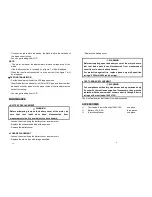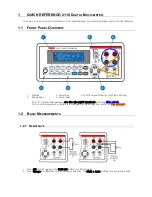
- Forward DC Current: approx. 1mA
- Reversed DC Voltage: approx.2.8V
- Overload Protection: 250V DC or rms AC
DC Current
Range
Resolution
Accuracy
200μA
0.1μA
±
(
1.0% of rdg + 2 digits
)
2mA
0.001mA
20mA
0.01mA
±
(
1.5% of rdg + 2 digits
)
200mA
0.1mA
10A
0.01A
±
(
3.0% of rdg + 2 digits
)
-
Overload Protection: μA, mA ranges: F 200mA/250V fuse (quick
acting), 10A range: unfused.
- Max. Input Current: mA Jack: 200mA, 10A Jack: 10A
- voltage drop: 200mV
Resistance
Range
Resolution
Accuracy
200
Ω
0.1
Ω
±
(
1.0% of rdg + 3 digits
)
2k
Ω
0.001k
Ω
20k
Ω
0.01k
Ω
±
(
1.0% of rdg + 2 digits
)
200k
Ω
0.1k
Ω
2M
Ω
0.001M
Ω
- Open Circuit Voltage: 2.8V
- Overload Protection: 250V DC or rms AC
Transistor hFE
Range
Function
hFE
Display: read approximate hFE value (0-1000) of
transistor under test (ALL TYPE)
- Base Current: approx. 2
µ
A
,
Vce: approx. 2.8V
- 6 -
OPERATING INSTRUCTION
●
DATA HOLD
If you need data hold when measuring, you can press on “H” button, it
will hold the reading; if you press the button again, data hold will not
continue.
●
PREPARATION FOR MEASUREMENT
- Turn on the meter. If the battery voltage is less than 3.6V, display will
show “
”, the battery should be changed at this time.
- The “
- Select a function and a range for the item to be measured by rotating
the transform switch to the selected position. When the value scale
to be measured is unknown beforehand, set the range selector at the
highest position.
” besides the input jack shows that the input voltage or
current should be less than specification on the sticker of the meter
to protect the inner circuit from damaging.
- When connecting, first connect to the public testing line, then to the
electriferous testing line. When you remove it, you should remove
the elecriferous one first.
●
MEASURING DC VOLTAGE
You can’t test voltage which more than 1000V DC, it’s possible
to show higher voltage, but it may destroy the inner circuit.
WARNING
Pay attention not to get an electric shock when measuring
high voltage.
- Connect the black test lead to the COM jack and the red test lead to
the V jack.
- Set the transform switch at the
V range position.
- Connect test leads across the source or load under measurement.
- You can get a reading from LCD display. The polarity of the red test
lead connection will be indicated.
- 7 -
























